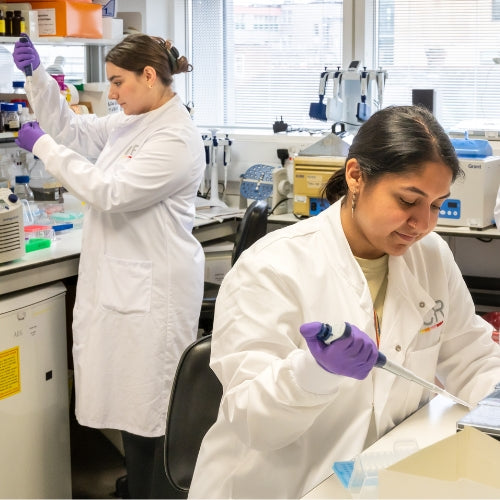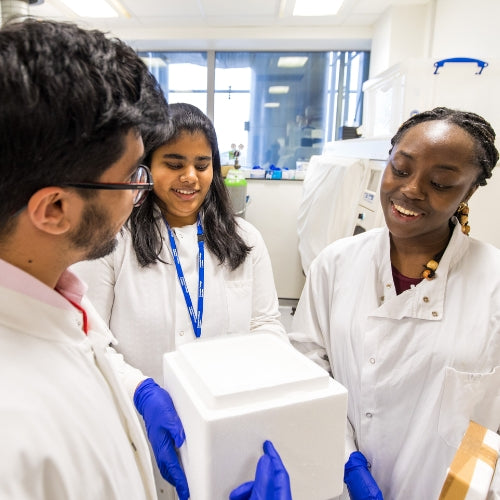Glioma

What is a glioma brain tumour?
A glioma is a type of brain tumour that has developed from the cells that should have become healthy support cells in the brain. These support cells are known as glial cells and include astrocytes, oligodendrocytes and ependymal cells – all of which have essential roles in the maintenance and function of the central nervous system.
There are many types of glioma tumours which can vary from low-grade (slow-growing) to high-grade (faster-growing). Some are also more common in adults, while others in children.
Examples of gliomas include glioblastoma, astrocytoma, oligodendroglioma and diffuse midline glioma (diffuse intrinsic pontine glioma).
What are the symptoms of a glioma?
The symptoms of a glioma tumour can vary significantly between patients, depending on the tumour’s location, size and growth rate.
Common symptoms include:
-
Persistent headaches, often worse in the morning
-
Seizures, which can vary in type and severity
-
Nausea and vomiting, especially in the morning
-
Vision problems, such as blurred or double vision (diplopia)
-
Cognitive or personality changes, including memory issues and confusion
-
Weakness or numbness on one side of the body
How are gliomas diagnosed?
Doctors use Magnetic Resonance Imaging (MRI) to obtain highly detailed images of the brain, which help in detecting any abnormalities. If the scan indicates the presence of a glioma, the patient is referred to a team of specialists for further evaluation and treatment.
The patient's case is reviewed by a multidisciplinary team (MDT), which includes neurosurgeons, oncologists, radiologists and clinical nurse specialists. They combine the results from MRI scans, biopsies and genetic tests to make a detailed diagnosis and develop a treatment plan.
-
MRI scan
This special imaging test that utilises magnetic fields helps doctors see detailed pictures of your brain and identify any abnormalities.
-
Referral to specialists
If the MRI shows signs of a glioma, you will be referred to a team of specialists who are experts on brain tumours. They will take over your care and guide you through the next steps.
-
Advanced MRI techniques
For tumours that appear to be less aggressive (low-grade), doctors may use advanced MRI techniques, such as MR perfusion and MR spectroscopy. These tests provide more information about the tumour and help determine if it might become more aggressive.
-
Biopsy and genetic testing
Through surgery, a sample of the tumour will be taken (biopsy) and examined under a microscope. Doctors will also test for specific genetic markers. These tests help identify the type of glioma and predict how it might behave.
-
Additional testing for high-grade gliomas
If the tumour is found to be high-grade, additional genetic tests will be done. These tests check for specific mutations that influence treatment options and prognosis.
What are the different types of glioma?
There are several types of gliomas, based on the type of glial cell they originate from and whether there have been any changes to particular genes and proteins inside the cells.
Doctors use a system for classifying brain tumours into groups and types. This system is regularly updated, and the latest edition is known as the 2021 World Health Organization (WHO) Classification of Central Nervous System Tumours.
The classification reflects that there are some gliomas that are more common in adults and some that are more common in children – these are known as adult and paediatric-type gliomas. However, sometimes adults can develop paediatric gliomas and children can develop adult gliomas.
Some tumours are referred to as ‘diffuse’. This describes how tumour cells spread and infiltrate surrounding healthy brain tissue. Unlike more circumscribed (solid) tumours, diffuse gliomas lack well-defined borders, making surgical removal more difficult. This trait often results in a more challenging prognosis and a higher chance of recurrence, even after treatment.
-
Adult diffuse gliomas
Adult diffuse gliomas are infiltrative tumours that spread into surrounding brain tissue, making them difficult to remove completely. They are classified based on specific genetic markers. The main types include:
Astrocytoma, IDH-mutant
Oligodendroglioma, IDH-mutant, and 1p/19q-codeleted
Glioblastoma, IDH-wildtype -
Paediatric diffuse gliomas
In the past, children's brain tumours were sometimes grouped with adult brain tumours, but research now shows they are different. The most recent classification guidance from the World Health Organization separates children's brain tumours from adult ones and divides them into low-grade (1-2) and high-grade (3-4) categories.
Paediatric-type diffuse low-grade gliomas
Paediatric-type diffuse high-grade gliomas -
Circumscribed astrocytic glioma
Circumscribed astrocytic gliomas are glioma tumours that are known for their ‘solid’ growth pattern with well-defined clear boundaries, distinguishing them from diffuse gliomas which have poorly defined, infiltrative margins. The main types include:
Pilocytic astrocytoma
Subependymal giant cell astrocytoma (SEGA)
Pleomorphic xanthoastrocytoma (PXA) -
Ependymoma
Ependymomas arise from ependymal cells lining the ventricles of the brain and the central canal of the spinal cord. They can occur at any age but are more common in children. Types include:
Subependymomas (Grade 1), slow-growing tumours often found in the ventricles
Classic ependymomas (Grade 2), the most common type, which can occur in both children and adults
Anaplastic ependymomas (Grade 3), more aggressive and likely to recur after treatment
What are the different grades of glioma?
All brain and central nervous system (CNS) tumours are divided into four grades, 1-4.
The grade of a glioma brain tumour gives an indication as to how the tumour is expected to behave (develop). It is based on cells examined using a microscope, as well as genetic and epigenetic changes (which genes are turned on or off) that are discovered during molecular testing in a laboratory.
-
Grade 1 glioma (low-grade glioma)
Grade 1 gliomas usually occur in children and teenagers. They are the most slow-growing (low-grade) form of glioma brain tumour and carry the longest prognosis.
The most common form of low-grade glioma is a pilocytic astrocytoma, which rarely progresses to a higher grade and can sometimes be completely removed by surgery. -
Grade 2 glioma (low-grade glioma)
Grade 2 gliomas are more common in adults but can also occur in children and teenagers. They are initially a slow-growing (low-grade) form of brain tumour but often progress to a higher grade through time – usually over years. As prognosis varies between individuals, patients’ clinicians are best placed to advise how long this process may take.
Oligodendroglioma are often classified as grade 2 gliomas. -
Grade 3 glioma (anaplastic glioma)
Grade 3 gliomas are classed as an aggressive form of brain cancer. They often spread to other parts of the brain and are more challenging to treat.
In these tumours, glioma cells are dividing rapidly. These were previously known as anaplastic brain tumours. -
Grade 4 glioma (including glioblastoma)
These are fast-growing, aggressive tumours which are very difficult to treat.
Examples of grade 4 gliomas include astrocytoma grade 4 and glioblastoma.
What are the treatments for glioma?
Glioma cancer treatment involves a multidisciplinary approach that may include surgery, radiation therapy (radiotherapy) and chemotherapy. The specific treatment plan depends on factors such as the type and grade of the glioma, its location within the brain and the overall health of the patient.
Here is an overview of the primary treatment options:
-
Surgery
Surgery to remove as much of the tumour as possible is recommended within six months of diagnosis for low-grade gliomas and urgently for high-grade gliomas.
The goal of surgery is to remove as much of the tumour as possible while preserving essential brain functions. Surgery also allows for histological and molecular diagnosis of the tumour. Complete removal might be challenging or ill-advised, especially if the tumour is in critical or inaccessible areas of the brain.
Surgery is different from a biopsy, which takes a small amount of tissue solely for histological and molecular diagnosis. -
Active monitoring
Some low-grade patients with no residual tumour following surgery may be offered active monitoring. This involves regular scanning of the tumour at set intervals to monitor its progression.
-
Radiation therapy
Radiotherapy aims to destroy cancer cells while minimising damage to surrounding healthy tissue. It is often used after surgery to eliminate any remaining tumour cells and reduce the risk of recurrence. It can also be used as a primary treatment when surgery is not possible or as a palliative treatment to relieve symptoms.
-
Chemotherapy
Chemotherapy aims to kill cancer cells or stop them from growing and dividing. It can be used as a primary treatment, in combination with other treatments like surgery and radiotherapy, or as a palliative treatment to relieve symptoms.
Chemotherapy drugs can include temozolomide and PCV (procarbazine, loumstine [CCNU] and vincristine). -
Targeted therapy
Targeted therapies aim to interfere with specific molecules involved in the growth and progression of cancer cells.
-
Immunotherapy
Immunotherapy involves harnessing the body's immune system to recognise and attack cancer cells. It is a promising area of research but is not yet standard treatment for gliomas.
-
Clinical trials
Clinical trials are research studies that explore whether a medical strategy, treatment, or device is safe and effective for humans. They are essential for developing new treatments and improving existing ones.
Participating in clinical trials can be beneficial for several reasons: participants may receive cutting-edge treatments before they are widely available, are closely monitored by healthcare professionals which can lead to better overall care and they contribute to medical research that can benefit future patients. -
Supportive care
Glioma treatment may have side effects and supportive care is essential to manage symptoms such as pain, seizures, and neurological deficits.
Physical and occupational therapy may be employed to help patients regain or maintain functional abilities. -
Follow-up care
After a glioma diagnosis, follow-up care involves regular scans (such as MRI or CT) to monitor the tumour and detect any changes or recurrence.
Patients have ongoing consultations to assess their health and adjust their care plan as needed.
What is the prognosis for a glioma tumour?
The survival rate for glioma can vary widely depending on the specific type and grade of the tumour, as well as the individual's age, overall health and other factors.
Low-grade gliomas tend to have a more favourable prognosis than high-grade gliomas, which grow more aggressively. For example, pilocytic astrocytoma tumours rarely progress to a higher grade and can sometimes be completely removed by surgery. Whereas glioblastoma, a grade 4 tumour, is incredibly aggressive and often returns following treatment.

What causes a glioma brain tumour?
No single, definitive cause has yet been identified for brain tumours. Some risk factors have been identified, but due to the complex and unique health history for each patient, scientists are still unable to answer this fundamental question.
We need to fund more research in order to understand how gliomas and other brain tumours are caused.
Doctors use a system to group (classify) brain tumours into different groups and types. The World Health Organisation (WHO) regularly update this system. The information in this page is based on the latest WHO classification of 2021.
Collapsible content
References
Overview | Brain tumours (primary) and brain metastases in over 16s | Guidance | NICE
NHS England » Clinical Commissioning Policy: Stereotactic radiosurgery (SRS) and stereotactic radiotherapy (SRT) to the surgical cavity following resection of cerebral metastases (All ages)
New life-extending drug treatment for children and teenagers with an aggressive form of brain cancer | NICE
Immune checkpoint inhibitors in cancer: pharmacology and toxicities - The Pharmaceutical Journal
